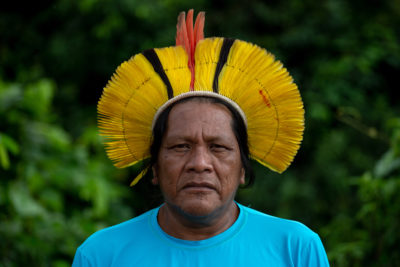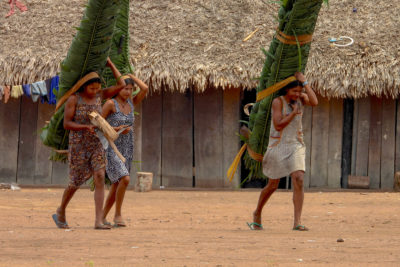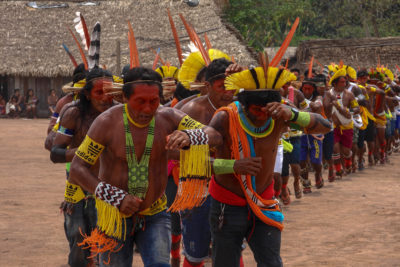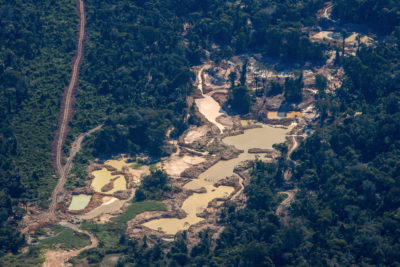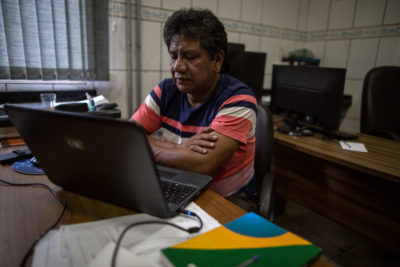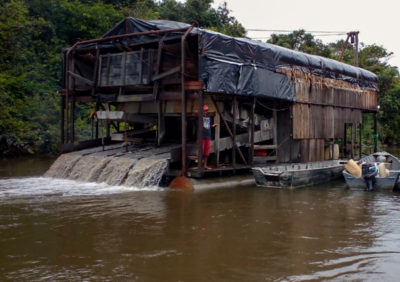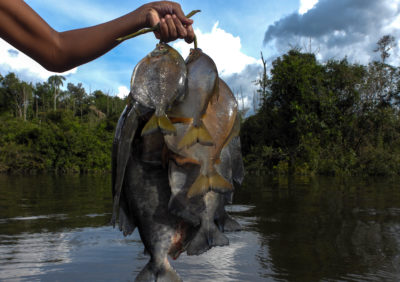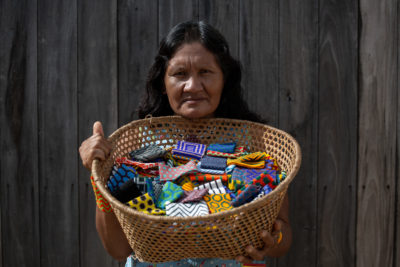For more than four decades, Kokoró Mekranotire has watched with dismay as outsiders have laid waste to ever-larger swaths of his Kayapó homeland. Loggers, gold miners, farmers, and land grabbers have streamed illegally into and around the Indigenous territory, a 40,000-square-mile expanse of forest the size of South Korea. The patch of forest where Mekranotire used to collect Brazil nuts — a dense canopy of deep golden-brown trees standing almost 100 feet tall — was stripped. Stands of cumaru trees, a Brazilian teak, were felled to make decks, cabinetry, and flooring. Loggers have repeatedly entered Kayapó land, removed what was in their way, and taken the rest to make a profit.
“Those trees never should have been touched,” says Mekranotire, now 49 and working for the Kabu Institute, a nonprofit that helps protect Kayapó land and develop sustainable businesses among its people, including Brazil nut cultivation. “We had to fight to hold onto our land and let more trees grow.”
Outsiders started arriving in droves in the 1970s with the opening of the federal BR-163 highway, which stretches 1,320 miles from Cuiabá in south-central Brazil to Santarém in the heart of the Amazon. BR-163 parallels Kayapó land and was fully paved by 2020, spurring a boom in soybean farming, with the highway providing easy access for millions of tons of the commodity crop to reach Brazilian ports.
“We’re fighting a war against politicians who want to destroy us and our land,” says a Kayapó activist.
The paving also provided much easier outside access to two important Kayapó reserves, Menkragnoti and Baú, measuring more than 18,000 square miles and 6,000 square miles, respectively. Illegal loggers and miners who used to arrive in a trickle, Mekranotire says, started gushing in. “The kuben [white men] already had a lot of experience; they knew exactly what they were doing,” he says. “But not all of our leaders did. They told us the highway wouldn’t affect us. It was a lie.”
Now, as Brazil’s nationalist President Jair Bolsonaro continues his push to legalize a broad range of economic and extractive activities on Indigenous land, plans are underway for a railway to help transport soybeans from the region’s burgeoning number of farms. And even though the Kayapó are one of the strongest and best-known Indigenous groups in the Brazilian Amazon — they have led the fight for Indigenous rights for 40 years — Bolsonaro’s anti-Indigenous policies are posing a significant threat.
“We’re fighting a war,” says Doto Takakire, who also works at the Kabu Institute. “A war against politicians who want to destroy us and our land.”
Located on a plateau in central Brazil, far south of the Amazon River and in the states of Mato Grosso and Pará, Kayapó land is the largest tract of Indigenous territory in Brazil and the largest swath of relatively pristine forest in the Amazon’s southeast, a region known as the ”arc of deforestation.” Despite continuing incursions — the Kayapó lost 3 million acres of land on their eastern border to logging, mining, and other development in the 1980s and 1990s — the group’s territory retains remarkable biodiversity, with jaguars, giant otters, harpy eagles, abundant fish populations, and vast forest areas.
Numbering only 9,400 people, the Kayapó live in villages on the Xingu River and its tributaries. The men fish and hunt animals such as tapir, capuchin monkeys, peccary, and deer. Women raise children, tend extensive gardens, and make trips into the forest to collect Brazil nuts, cumaru, açaí berries, and other fruits.
In the 1980s and 1990s, the Kayapó made international headlines as they moved to obtain legal rights to their traditional lands. Led by Chief Raoni Metuktire, who would eventually be nominated for the 2020 Nobel Peace Prize, they were joined by musician Sting in their fight to protect the Amazon rainforest, spawning nonprofits like the Rainforest Fund. Other groups, such as the International Conservation Fund of Canada and Conservation International, have helped the Kayapó defend their territories, providing boats, radios, and aerial surveillance data so the Kayapó can patrol their 1,250 miles of border.
“If there were no more Kayapó territory, then there would definitely be no more forest at all,” says Renata Pinheiro, senior manager for Indigenous people and social policies at Conservation International Brasil. “They’re on the agricultural frontier.”
The Kayapó’s fight has been part of a larger movement to demand Indigenous land rights in Brazil following centuries of oppression. The implementation of Brazil’s Constitution in 1988, including article 231, which outlines those rights as well as the federal government’s responsibility to demarcate and protect the land, gave them recourse. It didn’t, however, mean that those theoretical protections would always work in practice.
Left: Kayapó women carry bundles of leaves to a village ceremony. Right: Kayapó men in a traditional ceremony.
In the decades to come, all Indigenous land — Brazil has 305 Indigenous groups — would continue to come under threat, whether or not the groups had already completed the slow process of demarcation and official government recognition. Illegal mining, logging, fishing, and land theft, as well as the construction of highways, railways, and hydroelectric dams, have continued to impinge upon Indigenous territories.
The Yanomami, who live in the Amazon rainforest bordering Venezuela, are still in a longstanding fight to remove more than 20,000 illegal miners from their land, which is rich in gold. In Mato Grosso do Sul — a state that encompasses the tropical savanna known as the Cerrado and the world’s largest tropical wetland, called the Pantanal — the Guarani Kaiowá are trying to take back land lost to ever-advancing farming, facing violent attacks and the burning of their prayer houses. And the Kambiwá, Pataxó, and Pataxó Hã-Hã-Hãe in the state of Minas Gerais, who lost their land in the 2019 Brumadinho dam disaster, continue to confront land grabbers trying to take over their new territory.
The construction of the BR-163 highway was part of the National Integration Plan implemented by Brazil’s military dictatorship — a project designed to bring Indigenous groups under government control, occupy the Amazon, and take over the land. Anything and anyone in the way would be removed.
By the time the highway opened in 1976, many Kayapó had succumbed to outbreaks of disease brought to the region by outsiders, and just 20 percent of the Kayapó living on what would become the Baú reserve survived. They no longer had access to the Jamanxim River and lost 1,158 square miles of land to wildcat miners, loggers, and squatters, which they agreed to give up in exchange for what would be an empty promise to put an end to invasions of their territory.
With their land placed under federal protection — the Baú reserve in 2008 and the Menkragnoti reserve in 1993 — the Kayapó thought the threats would subside. But they haven’t. Deforestation has continued to threaten both reserves, as more and more trees are felled closer to their borders. According to the Kabu Institute, the deforestation on non-Indigenous land surrounding the Menkragnoti and Baú reserves almost tripled in 18 years, jumping from 4,450 square miles in 2000 to more than 12,580 square miles in 2018.
And deforestation on Indigenous land itself — illegal in Brazil under federal law — hasn’t stopped. A recent study from the research institute, Imazon, showed that almost 67,000 acres of forest in the state of Pará were lost to unauthorized logging between August 2019 and July 2020. Of that total, 390 acres were on the Baú reserve. According to Dalton Cardoso, an Imazon researcher, the south of Pará, where Kayapó land is located, contains abundant old-growth wood, prized by illegal loggers. The region’s ever-expanding network of highways, he says, has also “given loggers access to areas that were previously unreachable.”
Kayapó leaders know that the proposed railroad will bring more soybean farmers close to their land.
It has emboldened them, too. Doto Takakire is from the Baú reserve. Because of his work with the Kabu Institute, he often travels back and forth between his home in the forest and Novo Progresso, a nearby town that sits on the BR-163. Infamous for being at the center of August 2019’s Fire Day — when a group of farmers and ranchers got together to set a series of coordinated fires in the forest in support of Bolsonaro and his promise to open the Amazon to more development — the town is a staging point for men working in extractive industries.
It is also where some of them put pressure on the Kayapó.
Last year, Takakire says he was approached several times by loggers in town. Because of his ability to speak to Indigenous people living in Baú and Menkragnoti, the loggers thought he could convince the Kayapó to give them permission to work on their land. Knowing it was rich in prized ipê wood, or Brazilian walnut, they offered Takakire $10,000 Brazilian reais ($2,000) for his trouble. When he said no, they upped it to $20,000 Brazilian reais ($4,000). Again, he refused.
“I defend my people’s interests,” Takakire says. “If we stop, who will fight for us? Nobody.”
In August 2020, the Kayapó set up a blockade across the section of the BR-163 that runs through Novo Progresso. Wearing headdresses and painted faces, they demanded improvements in health care, the removal of illegal miners from their territories, and, most of all, to be consulted about plans to build a railway next to their land.
Known as the Ferrogrão, the railway would run 580 miles between Sinop, in Mato Grosso state, and Itaituba, in Pará, an important port city for the flow of agricultural commodities in the Amazon. The railroad’s main objective: to transport soy.
Soy production in Brazil is soaring, reaching an estimated 134 million tons last year and making the country the world’s third-largest soy producer. A study published last year noted that soy was responsible for 10 percent of deforestation across South America in the last 20 years, and that “the most rapid expansion occurred in the Brazilian Amazon, where soybean area increased more than tenfold.”
The Kayapó living on the Baú and Menkragnoti reserves don’t need to see these numbers to know that soy is taking over the region. The constant flow of trucks carrying soybeans on highway BR-163 makes it obvious, as do the farms that line the road. Bepdjo Mekragnotire, chief of the Baú village, located on the Kayapó’s Baú reserve, knows that the proposed railroad will bring more soy farmers close to Kayapó land.
On the Pixaxá and other rivers that are key arteries through Kayapó territory, warriors have recently been confronting gold miners illegally entering Indigenous land on makeshift rafts. The widespread, ad-hoc mining, which uses mercury to separate gold from other minerals, has already contaminated numerous rivers, like the Curuá, where the Kayapó once fished, collected drinking water, and bathed. According to a 2018 federal investigation into illegal mining, fish samples collected in the Curuá and Baú rivers showed levels of mercury well above what is recommended by the World Health Organization and the Brazilian health regulatory agency, ANVISA.
Left: An illegal mining raft that entered the Pixaxá River before being ejected by Kayapó warriors. Right: Fish caught in the Baú river. A federal investigation found that fish from the Baú contained high levels of mercury, which is used in mining.
No epidemiological studies of mercury have been done among the Kayapó people, but their concerns increased when a study by the scientific institution Fiocruz and WWF Brazil showed that 100 percent of the members of the neighboring Munduruku Indigenous group were contaminated with mercury, 60 percent at levels above what is considered safe. Contamination among riverside villagers jumped to 90 percent.
“We’ve had some babies born with developmental problems,” says Bepdjo Mekragnotire. “We wonder if it’s the mercury, but we just don’t know yet.”
Mining is illegal on Kayapó territory, but legal on adjacent land, with the requirement that the Kayapó are consulted regarding possible environmental and health effects. Nevertheless, mining is rampant where the Kayapó live, occasionally with the involvement of some Kayapó. Rich in gold, the entire region has attracted everything from the smallest wildcat operations to some of the biggest mining giants, including Serabi Gold, a company headquartered in the UK that owns and operates two gold mining complexes in the region, including one next to Kayapó land.
Bekwyitexo Kayapó, chief of Pukany village, holds a basket of beaded bracelets that she and other Kayapó women make and sell.
Ever since Jair Bolsonaro campaigned for president in 2018, vowing to open up Indigenous land to mining and end federal recognition of Indigenous territories, the Kayapó have been feeling the pressure. Since then, the president has repeated his promises several times, saying two months after his election, “I will not demarcate one more square centimeter of Indigenous land.”
In 2020, he pushed a bill to regulate the exploitation of resources on Indigenous reserves — legislation widely seen as further opening Indigenous territories to development. Brazil’s lower house of Congress voted this month to flag the bill as urgent, and it is expected to go to a vote in April. In February, Bolsonaro, who is up for reelection this year, signed a decree meant to encourage small-scale and artisanal mining. The government has denied this includes illegal mining, but environmentalists are concerned it could spur more unlawful mining in the Amazon.
“When I was young, I feared that the white men who came to our village were there to kill us and to take what was valuable from our land,” says Bekwyitexo Kayapó, chief of the Pukany village on the Menkragnoti reserve. “Now, I know that they’ve come to kill us in a different way. Now, I fear they’ll do it by taking our land.”

